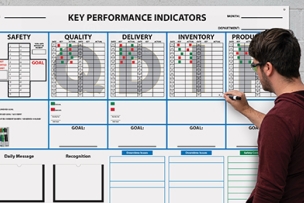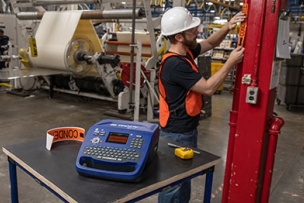One change of note was that “respiratory protection” rose up the rankings from fifth place in 2019 to third place in 2020, likely due to the fact that many companies were concerned with worker protection in relation to the COVID-19 pandemic, which has led to greater use of face coverings and respirators such as N95 masks in the workplace.
Here’s the top 10 list of OSHA’s most frequently cited violations for 2020:
- Fall protection, construction (29 CFR 1926.501)
- Hazard communication standard, general industry (29 CFR 1910.1200)
- Respiratory protection, general industry (29 CFR 1910.134)
- Scaffolding, general requirements, construction (29 CFR 1926.451)
- Ladders, construction (29 CFR 1926.1053)
- Control of hazardous energy (lockout/tagout), general industry (29 CFR 1910.147)
- Powered industrial trucks, general industry (29 CFR 1910.178)
- Fall protection—training requirements (29 CFR 1926.503)
- Eye and face protection (29 CFR 1926.102)
- Machinery and machine guarding, general requirements (29 CFR 1910.212)
Each of these violations comes with associated costs such as fines or lost workdays. J. J. Keller & Associates, a provider of regulatory, safety and compliance solutions, has put together a list of the violations and their costs and causes.
Here’s a look at OSHA’s top 10 list of violations for 2020, their costs and tips for avoiding them.
No. 1: Fall Protection Violations
Total 2020 violations: 4,198
Total 2020 penalties: $22,767,761
Many of OSHA’s most frequent violations in the workplace are related to standards that require employees to carry out a plan or predetermined procedure, which is sometimes overlooked due to a lack of training or adequate supervision. This results in employees sometimes inadvertently violating OSHA requirements.
To remedy this, companies should find ways to reinforce the safety requirements and ensure proper fall protection is provided when required. This may involve increased training or by using workplace signage to reinforce the need to follow the correct safety rules and procedures.
Another issue for companies dealing with fall protection is making sure work surfaces are as safe as possible. Some may not have the structural integrity to support employees, notes J. J. Keller: OSHA requires this, and “employers engaged in construction work should take a look at where employees will be working and ensure safety before work begins.”
Read more: Workplace Fall Protection: How to Use a Safety Harness and Lanyard
No. 2: Hazard Communication
Total 2020 violations: 2,198
Total 2020 penalties: $2,719,806
As with fall protection, the communication of information about the identities and hazards of the chemicals in the workplace requires companies to develop a communications program, as required by OSHA’s hazard communication standard. The standard has several requirements that are often not implemented properly.
One deficit found in hazard communication is the lack of a required written program, notes J. J. Keller: a written record of what a company has done to comply with OSHA’s standard.
“One of the program requirements is for you to compile a list of all the chemicals you use—in other words, a chemical inventory,” says J. J. Keller. “The inventory can be a daunting task to compile, but it is a requirement—the initial compilation is the hardest, but it’s also important (and required) for you to have a solid process for keeping the list up to date.”
Other common trouble areas for companies are the labeling of hazardous chemicals, not having updated safety data sheets for each chemical and lack of training programs for handling chemicals.
No. 3: Respiratory Protection
Total 2020 violations: 2,053
Total 2020 penalties: $3,172,334
Respiratory protection may be required when your employees are exposed to poor air quality or breathing hazards when working. This is often preceded by an assessment of your workplace exposures to determine the appropriate level of respiratory protection.
One common issue with this safety measure is the use of masks such as N95s. While employers may use face masks such as N95s for everyday protection, they may not realize that they are considered respirators and therefore must create a full written respiratory program, notes J. J. Keller. Employers may also not realize that employees should be medically evaluated to determine whether they are physically capable of wearing a respirator, which can place stress on the body. A lack of proper fit testing is another common respiratory protection violation.
Read more: Choosing the Best Industrial Face Masks and Coverings for Manufacturing: 3 Things to Know
No. 4: Scaffolding in Construction
Total 2020 violations: 1,750
Total 2020 penalties: $5,062,635
OSHA’s scaffolding standard includes several key provisions, including fall protection. Employees working at 10 feet or higher must be protected, but the type of protection depends on the type of scaffold, and whether a personal fall arrest system or guardrails are needed. Other noted violations are inadequate points of access for the scaffold platforms, or gaps in the scaffold platforms that can lead to dangerous falls. Not including a “competent person,” as required by OSHA, to monitor and oversee scaffold use at a job site is another potential violation by employers.
No. 5: Ladders in Construction
Total 2020 violations: 1,605
Total 2020 penalties: $4,785,679
Ladders may seem harmless, but falls from ladders are common job-site injuries in the U.S. Each year more than 500,000 people are treated—and more than 300 people die—because of ladder-related injuries, according to the National Institute for Occupational Safety and Health (NIOSH). Those injuries cost businesses an estimated $24 billion annually.
A common violation related to ladders is when they do not extend 3 feet above the upper landing surface, as required when they are used to access that landing surface, or when a ladder is not secured correctly. Other violations are when ladders are used as a walking platform or a lifting device (functions for which they were not designed), or when the ladder is defective and not tagged or withdrawn from use.
Read more: Ladder Safety Tips: What You Need to Know to Protect Your Workers
No. 6: Hazardous Energy (Lockout/Tagout)
Total 2020 violations: 1,599
Total 2020 penalties: $9,633,595
An important safety challenge in a facility is maintaining lockout/tagout procedures, which are critical to keeping workers safe by making sure they don’t turn on machines that are being serviced, or when maintenance is being performed.
OSHA’s lockout/tagout standard, 29 CFR 1910.147, addresses the safety of employees engaged in servicing and maintenance activities in general industry workplaces.
The most common violations of this standard happen when an employer fails to develop the required written energy control program that includes specific procedures for lockout/tagout, notes J. J. Keller. Other violations are related to employee training, use of inappropriate lockout/tagout devices and errors in procedure inspections.
No. 7: Powered Industrial Trucks
Total 2020 violations: 1,382
Total 2020 penalties: $3,765,006
Working with powerful industrial trucks such as forklifts or powered pallet jacks can present safety issues for companies. Common violations for this equipment include failing to train workers on the proper use of each type of equipment, or the operation of unsafe equipment, which may involve failing to inspect equipment on a regular basis and take it out of service when safety issues arise.
No. 8: Fall Protection—Training
Total 2020 violations: 1,262
Total 2020 penalties: $2,051,699
Falls in the workplace are one of the leading causes of workplace injuries and a perennial top 10 OSHA violation.
OSHA requires employers to provide a training program for each employee who might be exposed to fall hazards in the workplace, and the program should “enable each employee to recognize the hazards of falling” and “the procedures to be followed in order to minimize these hazards.”
Violations of this standard may include a failure to receive a written record verifying an employee’s training. Employees should also receive retraining when an employer has reason to believe that workers do not have the understanding and skill required to work safely.
No. 9: Eye and Face Protection
Total 2020 violations: 1,107
Total 2020 penalties: $3,521,988
Given the risk of injury from metal particles, dust, chemicals and other airborne hazards in the workplace, eye and face protection is critically important in manufacturing facilities. That’s why employers must assess the hazards in their facilities and provide proper eye and face protection for workers. Failure to do so can lead to a violation. And the protection must be ANSI-approved.
Of note for employers is the fact that face shields can only be used as secondary protection for the eyes and do not provide full eye protection alone. They should be used with safety glasses or goggles.
Read more: Eye Protection Guide: Picking the Right Safety Glasses and Goggles
No. 10: Machinery and Machine Guarding
Total 2020 violations: 985
Total 2020 penalties: $6,932,297
Injuries from heavy equipment can be devastating and even lethal, so OSHA puts emphasis on machine guarding. Under its guarding requirement—the “General requirements for all machines” standard—OSHA requires that one or more methods of machine guarding be provided to “protect the operator and other employees in the machine area from hazards such as those created by point of operation, ingoing nip points, rotating parts, flying chips and sparks.”
How are you making sure your employees are safe at work? Share your thoughts in the comments below.





Talk to Us!
Leave a reply
Your email address will not be published. Required fields are marked *